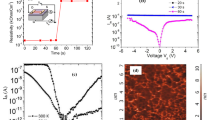Abstract
A tunnel field-effect quantum-well nanotransistor, in which the drive voltage of 0.6 V is applied to the barriers surrounding the well, and electrons are drained from the quantum well, is considered. Electrons are tunneled into the quantum well through the first half of the double-humped tunnel barrier (double heterojunction) formed by a three-layer sandwich of broad-band 2D semiconductors (graphene derivatives, such as perhydroxy graphene (COH) n , fluorographene (CF) n , and graphane (CH) n ) with sharply different levels of the bottoms of the conduction band. The middle fluorographene (CF) n layer has the lowest conduction band bottoms, which forms the quantum well with a depth of ∼3 eV and a width of ∼0.6 nm in the common tunnel potential barrier with a width of 1.8 nm and serves as a drain channel for electrons. The source and gate metallic electrodes are adjacent to the outer layers of the sandwich 2D semiconductors, i.e., perhydroxy graphene (COH) n and graphane (CH) n , respectively, forming the common gate sandwich of 20 × 20 nm2 in size. The metallic drain electron with a width of 10 nm and a potential, which is 1 V higher than that of the first (source) electrode, is adjacent to the middle fluorographene (CF) n layer, which extends outside the sandwich, being 35 nm wider than the outer 2D semiconductor layers of the inner three-layer sandwich. The gate opening potential is 0.62 V. The maximum working voltage I sd = 2 × 10−5 A. The drain off-state current is zero, and the leakage on-state current through the gate electrode is I g = I leak ∼ 10−10 A. The quantum capacitance of the transistor enables its operation at a frequency of up to 1012 Hz.
Similar content being viewed by others
References
Seabaugh, A.C. and Zhang, Q., Low-voltage tunnel transistors for beyond CMOS logic, Proc. IEEE, 2010, vol. 98, no. 12, pp. 2095–2110.
Ionescu, A.A. and Riel, H., Tunnel field-effect transistors as energy-efficient electronic switches, Nature, 2011, vol. 479, no. 17, pp. 329–337.
Britnell, L., Gorbachev, R.V., Jalil, R., Belle, B.D., et al., Field-effect tunneling transistor based on vertical graphene heterostructures, Science, 2012, vol. 335, no. 6071, pp. 947–950.
Svintsov, D.A., Vyurkov, V.V., Lukichev, V.F., and Orlikovsky, A.A., Tunnel field-effect transistors with graphene channels, Semiconductors, 2013, vol. 47, no. 2, pp. 279–284.
Svintsov, D., Vyurkov, V., Orlikovsky, A., Ryzhii, V., and Otsuji, T., All-graphene field-effect transistor based on lateral tunneling, J. Phys. D: Appl. Phys., 2014, vol. 47, no. 9, p. 094002.
Geim, A.K. and Grigorieva, I.V., Van der Waals Heterostructures. http://arxiv.org/ftp/arxiv/papers/1307/1307.6718.pdf. Cited August 2, 2014.
Chang, L.L. and Esaki, L., Tunnel triode—a tunneling base transistor, Appl. Phys. Lett., 1977, vol. 31, no. 10, p. 687.
Sze, S.M. and Ng, K.K., Physics of Semiconductor Devices, New York: Wiley, 1981, vol. 2, pp. 145–146.
Luryi, S., Quantum capacitance devices, Appl. Phys. Lett., 1988, vol. 52, no. 6, pp. 501–503.
Fana, Z.Y. and Li, J., AlGaN/GaN/AlN quantum-well field-effect transistors with highly resistive AlN epilayers, Appl. Phys. Lett., 2006, vol. 88, no. 7, p. 073513.
Kendall, R.A., Aprà, E., Bernholdt, D.E., Bylaska, E.J., Dupuis, M., Fann, G.I., Harrison, R.J., Ju, J., Nichols, J.A., Nieplocha, J., Straatsma, T.P., Windus, T.L., and Wong A.T., High performance computational chemistry: an overview of NWChem a distributed parallel application, Comput. Phys. Commun., 2000, vol. 128, nos. 1–2, pp. 260–283.
Huzinaga, S., Andzelm, J., Klobukowski, M., Radzio-Andzelm, E., Sakai, Y., and Tatewaki, H., Gaussian Basis Set for Molecular Calculations, Amsterdam: Elsevier, 1984.
Kittel, Ch., Elementary Solid State Physics, New York: Wiley, 1962.
Kasap, S.O., Principles of Electronic Materials and Devices, New York: McGraw-Hill, 2002, http://Materials.Usask.Ca
Bardeen, J., Theory of the work functions. II: The surface double layer, Phys. Rev., 1936, vol. 49, no. 9, pp. 653–663.
Bardeen, J., The image and van der Waals forces at a metallic surface, Phys. Rev., 1940, vol. 58, no. 8, pp. 727–735.
Juretchke, H.J., Exchange potential in the surface region of a free electron metal, Phys. Rev., 1953, vol. 92, no. 5, pp. 1140–1144.
Simons, J.G., Duke, C.B., and Kane, E.O., in Tunneling Phenomena in Solids, Burstein, E. and Lundquist, S., Eds., New York: Plenum Press, 1969, ch. X, IV, and I.
Seitz, F., The Modern Theory of Solids, New York: McGraw-Hill, 1940.
Zhukov, V.A. and Maslov, V.G., I-V characteristics and the spectrum width during electron tunneling through nanosandwiches W-WO2-(Au −147 )-Al2O3-Al and Nd-Nd2O3-(Au −55 )-Nd2O3-Nd. Part I: Quantumchemical calculation of energies of orbitals for anions of nanoclusters Au55 and Au147, Russ. Microelectron., 2012, vol. 41, no. 2, pp. 122–131.
Zhukov, V.A. and Maslov, V.G., A model of a metallic quantum nanotransistor with a Coulomb-blockage gate in “magic” Au55 and Ag55 nanocrystals with speed of 1011 Hz, Russ. Microelectron., 2013, vol. 42, no. 2, pp. 134–145.
Washburn, S. and Webb, R.A., Aharonov-Bohm effect in normal metals. Quantum coherence and transport, Adv. Phys., 1986, vol. 35, no. 4, pp. 375–422.
Imry, Y., Introduction to Mesoscopic Physics, New York: Oxford University Press, 1997.
Torres, J.A., Pascual, J.I., and Sáenz, J.J., Theory of conduction through narrow constriction in a three-dimensional electron gas, Phys. Rev. B: Solid State, 1994, vol. 49, no. 23, pp. 16581–16584.
Author information
Authors and Affiliations
Corresponding author
Additional information
Original Russian Text © V.A. Zhukov, V.G. Maslov, 2015, published in Mikroelektronika, 2015, Vol. 44, No. 2, pp. 108–119.
Rights and permissions
About this article
Cite this article
Zhukov, V.A., Maslov, V.G. A tunnel field-effect transistor with a graphene derivatives (COH) n -(CF) n -(CH) n three-layer quantum well with the middle (CF) n drain layer. Russ Microelectron 44, 89–100 (2015). https://doi.org/10.1134/S1063739714060109
Received:
Published:
Issue Date:
DOI: https://doi.org/10.1134/S1063739714060109



